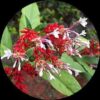- Empty cart.
- Continue Shopping
Irattimadhuram
₹750.00Current price is: ₹750.00. Original price was: ₹1,090.00.
Genus : Glycyrrhiza
“Introducing the Irattimadhuram Plant, a stunning addition to any plant lover’s collection. With its vibrant colors and graceful foliage, it brings a touch of elegance to your indoor or outdoor space.”
Add to WishlistRemove from Wishlist
Add to Wishlist
Out of stock
Glycyrrhiza glabra, commonly known as licorice, is a perennial plant native to Europe, Asia, and the Mediterranean region. It is best known for its sweet root which has been used for centuries for medicinal purposes as well as for its sweet flavor in confectionary and food.
The plant grows to a height of 1-2 meters and has a fibrous root system with oblong leaves and blue or purplish flowers. The root is the part of the plant used for medicinal and culinary purposes. Licorice root contains compounds such as glycyrrhizin, which is responsible for its characteristic sweet taste, as well as various phytochemicals and flavonoids.
In traditional medicine, licorice root has been used to treat a variety of ailments including digestive problems, respiratory issues, skin conditions, and coughs. It has also been used as an anti-inflammatory, to boost the immune system, and to support liver health.
Licorice root is available in several forms including teas, extracts, syrups, and candies. It is important to note that excessive consumption of licorice root can lead to health problems such as high blood pressure, electrolyte imbalances, and other side effects. Before using licorice root for medicinal purposes, it is always recommended to consult with a healthcare provider.
Add a review
Currently, we are not accepting new reviews














Reviews
There are no reviews yet